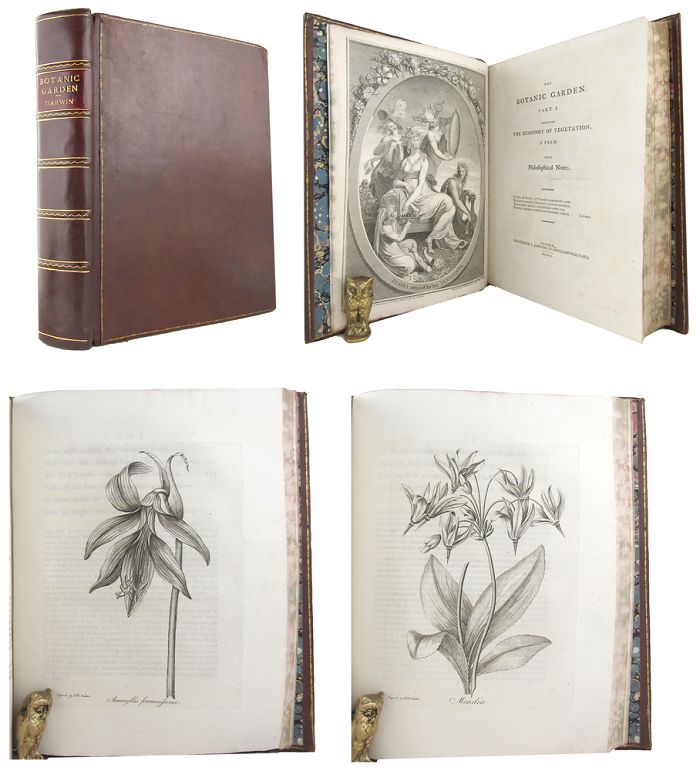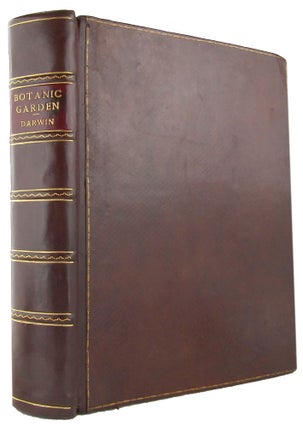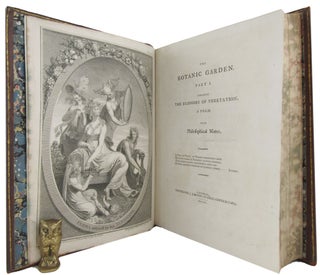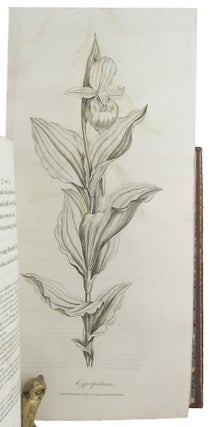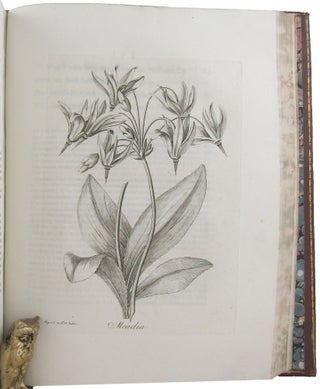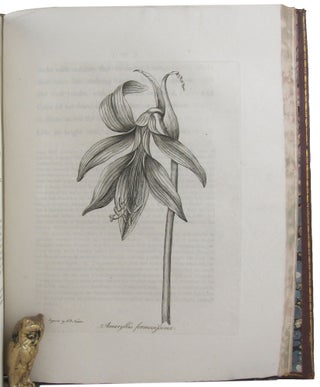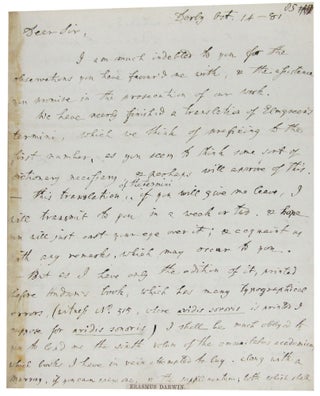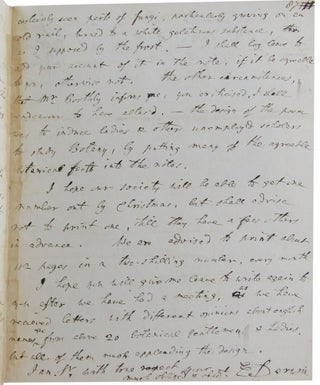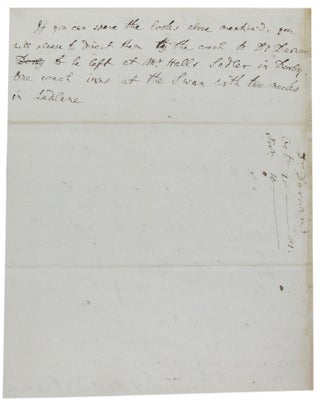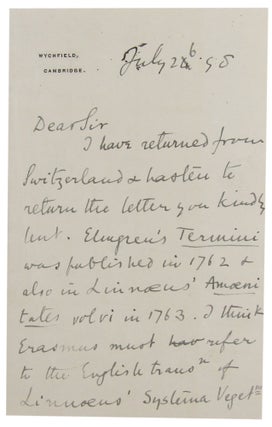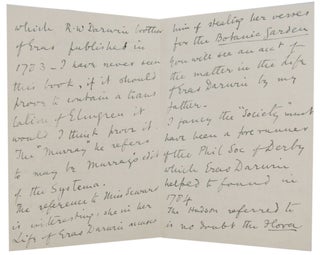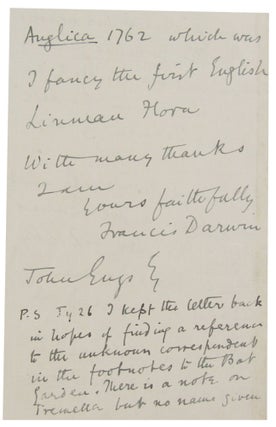THE BOTANIC GARDEN; A Poem, in Two Parts.
Part I. Containing The Economy of Vegetation. Part II. The Loves of the Plants. With Philosophical Notes. [Two parts in one volume]. Part I: Pp. xii+214(including minor mispagination)+126 (additional notes)+[2](errata, verso advertisement), engraved frontispiece and 9 plates (one folding); Part II: Pp. [iv]+x+198(last errata, verso blank), engraved frontispiece, 9 plates and a tailpiece; demy 4to; early diced russia boards with thin decorative gilt border and gilt edges, recently rebacked with sympathetic leather spine, gilt lettered red leather title label and raised bands decorated in gilt; marbled edges and endpapers; bookplate [Jas. Stewart of Killymoon] on upper pastedown, hinges neatly strengthened, short closed tear to inner edge of folding plate a little light foxing and occasional slight soiling; printed for J. Johnson, London, 1791. First edition of Part I and Third edition of Part II, being the First edition of the complete work. Bentley, Blake Books, 450A: 'The first two editions of Part II and the first three editions of Part I were issued in several combinations with the 1791 general title-page.' *With an autograph letter, signed, from Erasmus Darwin to Sir Joseph Banks, dated October 14 [17]81: 4 pages, small 4to, the hinge neatly reinforced and with light glue stains, small printed name label \lquote ERASMUS DARWIN' at foot of first page. This is accompanied by a shorter ALs from Francis Darwin (son of Charles and great-grandson of Erasmus) to John Enys: 4 pages, small 8vo. [John Davies Enys (1837-1912) was a Cornish-born amateur naturalist who lived for several year in New Zealand. A keen plant collector, with a particular interest in ferns and mosses, he published numerous papers in the Transactions and Proceedings of the New Zealand Institute, the Transactions of the Royal Geological Society of Cornwall, and the Quarterly Journal of the Geological Society of London, of which he was a fellow. After his return to England in 1891 he was elected President of the Royal Institution of Cornwall in 1894]. Erasmus Darwin's letter to Banks is not addressed, and was previously known only from a copy made in the 1830s for the botanist and antiquary Dawson Turner (1775-1858). A summary of the letter (misdated Oct. 24), is included in The Banks Letters. A Calendar of the Manuscript Correspondence of Sir Joseph Banks, by Warren R. Dawson (British Museum, London, 1958). Banks' identity could also be deduced from the text of the letter, which contains queries and comments by Darwin relating to the translation of Linnaeus he was preparing for publication by the Botanical Society at Litchfield, plus requests to borrow books which would assist with his research. Siobhan Carroll, On Erasmus Darwin's The Botanic Garden, 1791-1792 confirms that \lquote Darwin had borrowed books from Banks in composing his translations of Linnaeus and, during the 1780s, had sought Banks's feedback on his efforts at "propagating the knowledge of Botany"'. Francis Darwin's letter to John Enys elucidates some of the aspects of the Erasmus Darwin letter, identifying some of the books mentioned. The early [original?] owner of this volume, James Stewart (1742-1821) of Killymoon Castle, was MP for County Tyrone, Ireland, for many years. Erasmus Robert Darwin (1731-1802) was an esteemed and influential English natural philosopher, physician, inventor, and poet. He was also the grandfather of Charles Darwin, and The Loves of the Plants (illustrating the Linnaean system of botany) and The Economy of Vegetation (charting progress from elemental chaos to the modern world and celebrating technological innovation and scientific discovery) suggest a theory of biological evolution. Five of the ten plates in Part I have been attributed to William Blake, although only one, Fertilization of Egypt, bears his name. The four Portland Vase plates (three of which are dated Dec. 1st, 1791) are not signed, but Bentley explains their attribution to Blake on the basis of a letter from the publisher, Joseph Johnson, to Erasmus Darwin in July 1791. (Johnson was the publisher for whom Blake did numerous engravings after he completed his apprenticeship). Most of the botanical plates in Part II are by Frederick Polydore Nodder (1770-1801), the artist who later helped Joseph Banks prepare the Florilegium. The Linnaean system of classification was the subject of much debate when Darwin was composing the earlier poem, The Loves of the Plants, which was originally published in 1789. Erasmus Darwin believed that Linnaeus's works should be translated as literally as possible, retaining the sexual references in the nomenclature. In his poem, Darwin not only embraced Linnaeus's classification system, but also his highly sexualized metaphors (hence the poem's title). The Economy of Vegetation also contains a brief Australian reference. An engraving of the anti-slavery medallion by Josiah Wedgwood (Charles Darwin's maternal grandfather and a friend of Erasmus Darwin) is featured on the plate opposite page 87 in Part I of The Botanic Garden, together with references to Botany Bay in the accompanying verse and footnote: Or with fair HOPE the brightening scenes improve,/And cheer the dreary wastes at Sydney-cove;/Or bid Mortality rejoice and mourn/O'er the fin forms on PORTLAND'S mystic urn. 'Alluding to two cameos of Mr. Wedgwood's manufacture; one of a Slave in chains, of which he distributed many hundreds, to excite the humane to attend to and to assist in the abolition of the detestable traffic in human creatures; and the other a cameo of Hope attended by Peace, and Art, and Labour, which was made of clay from Botany Bay; to which place he sent many of them to shew the inhabitants what their materials would do, and to encourage their industry. A print of this latter medallion is prefixed to Mr. Stockdale's edition of Phillips' Expedition to Botany Bay' [footnote, p. 87]. Together, three items (one volume and two letters:. Item #166255
Price: $20,000.00

